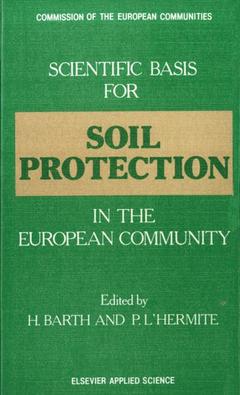Description
Scientific Basis for Soil Protection in the European Community, Softcover reprint of the original 1st ed. 1987
Coordinators: Barth H., L'Hermite P.
Language: English
Subjects for Scientific Basis for Soil Protection in the European...:
Keywords
Erosion; environment; pesticide; pesticides; pollution; soil; soil pollution; soil quality; ecotoxicology
Publication date: 09-2011
630 p. · 15.2x22.9 cm · Paperback
630 p. · 15.2x22.9 cm · Paperback
Description
/li>Contents
/li>
PH. BOURDEAU Directorate-General Science. Research and Development. Commission of the European Communities. Brussels. Belgium We are living on a unique planet, the only one in the solar system where life exists. The very existence of life has modified the physical and chemical environment of the earth, its atmosphere and oceans, in a way that makes life sustainable. This system with its complex cybernetic mechanisms has been named GAIA by Lovelock. Man has always interfered with it on a more or less limited scale. This interference is now reaching global proportions such as climate modifications resulting from CO and trace gas 2 accumulation in the atmosphere or the destruction of stratospheric ozone, not to speak of global radioactive contamination. GAIA will probably prevail as a living system but it probably does not give much importance to man's survival as such, and it is man that has to take care of his own survival. In the ecosystem of Planet Earth, soils are the thin interface between lithosphere and atmosphere which constitutes the essential substrate for the terrestrial biosphere, the productivity of which far exceeds that of the oceans, even though the latter cover a much larger area than the continents. Soils themselves are complex systems. They develop through weathering of minerals, are colonised by living organisms which in turn modify their substrate making it suitable for other organisms. This induces a primary ecological succession which eventually reaches a climax, in equilibrium between climate, soil and the biological communities.
Soil Protection Strategy in the Community.- Session I: Soil Protection—A Need for a European Programme?.- Wasting Europe’s Heritage—The Need for Soil Protection.- Land Resources and their Use in the European Communities.- The Production Potential of Soils: Part I—Sensitivity of Principal Soil Types to the Intensive Agriculture of North-Western Europe.- The Production Potential of Soils: Part II—Sensitivity of the Soil Systems in Southern Europe to Degrading Influxes.- Sensitivity of European Soils Related to Pollutants.- Sensitivity of European Soils to Ultimate Physical Degradation.- Session II: Assessment of Impacts on the Soil Environment.- Effects of Agricultural Practices on the Physical, Chemical and Biological Properties of Soils: Part I—Effect of Some Agricultural Practices on the Biological Soil Fertility.- Effects of Agricultural Practices on the Physical, Chemical and Biological Properties of Soils: Part II—Use of Sewage Sludge and Agricultural Wastes.- Effects of Agricultural Practices on the Physical, Chemical and Biological Properties of Soils: Part III—Chemical Degradation of Soil as the Result of Use of Mineral Fertilizers and Pesticides: Aspects of Soil Quality Evaluation.- Effects of Forestry Practices on the Chemical, Biological and Physical Properties of Soils.- Impacts on Soils Related to Industrial Activities: Part I—Effects of Abandoned Waste Disposal Sites and Industrial Sites on the Soil: Possible Remedial Measures.- Impacts on Soils Related to Industrial Activities: Part II— Incidental and Accidental Soil Pollution.- Impacts on Soils Related to Industrial Activities: Part III—Effect of Metal Mines on Soil Pollution.- Impacts on Soils Related to Industrial Activities: Part IV—Effects of Air Pollutants on the Soil.- Irrigation and Drainage for Improvement of Wet and Saline Soils. Reference to Portuguese Conditions.- Impact of Recreational and Tourist Activities on the Soil Environment.- Soil Losses from Erosion in Relation to Urbanism and Infrastructure.- Session III: The State of European Soils—Recovery, Protection and Strategies for Prevention.- Treatment and Reutilisation of Contaminated Sites.- Land Suitability Evaluation in Major Agro-ecological Zones and its Application in Land Use Planning and Nature Protection.- Optimizing the Use of Soils: New Agricultural and Water Management Aspects.- Soil Protection—Changes in Soil Characteristics and Species Dynamics: Landscape and Land Use Planning Requirements.- The Soil Protection Plan in the Federal Republic of Germany.- Soil Protection Programmes and Strategies in Other Community Member States: Examples from The Netherlands.- Soil Protection Programmes and Strategies in Other Community Member States: Setting up of an Observation Network for Soil Quality in France.- Soil Protection Programmes and Strategies in Other Community Member States: The UK Approach to Soil and Landscape Protection.- Soil Protection in Switzerland.- Strategies for Soil Protection under Intensive Irrigation in Israel.- Chemical Fate Modelling in Soil Systems: A State-of-the-Art Review.- Session IV: Conclusions, Recommendations and Research Needs.- Research Needs in Soil Protection: The Federal Ministry of Research and Technology’s Soil Research Programme.- Report on Session I: Soil Protection—A Need For A European Programme?.- Report on Session II: Assessment of Impacts on the Soil Environment.- Overall conclusions.- List of Participants.
© 2024 LAVOISIER S.A.S.




